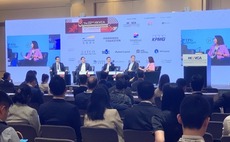
Asia secondaries: Worth the wait?

A host of pure-play and multi-strategy managers have allocated more resources to Asia in recent years to capture the nascent secondaries opportunity. The region if offering more but has yet to reach full maturity
The sale of Link Asset and Securities, one of the world's largest equity derivatives brokers, to ICAP in 2008 left Paul Robine looking for a new challenge. Having moved to Asia three years earlier to build out Link's business in the region, from his vantage point in Hong Kong Robine had witnessed the explosive growth in private equity. But he didn't want to address the opportunity in conventional fashion.
"There were already thousands of PE funds that were more or less doing the same thing - growth capital minority investments in China and India," he recalls. "On top of that there were already some very well established brands. Did we really want to be fund number 2,700 doing growth capital investments? Probably not."
This led to the creation of TR Capital, one of few independent pure secondary players in Asia that targets a combination of traditional LP positions in funds and directly-held stakes in companies. The firm has approximately $300 million under management across two funds, and has completed 25 transactions.
"In 2008 there were not many secondaries, but we have seen much more over the past three years. One reason is the older generation of funds created between 2003 and 2007 that are now reaching the end of their lives," says Robine. "A lot of them were betting on the IPO market for exits but those have not materialized. We think there is a huge opportunity over the next five years."
It is difficult to get an accurate picture of just how many Asia-focused funds were raised between 2000 and 2014; AVCJ Research puts it at more than 5,700, while TR Capital estimates there are over 3,000, excluding Japan and renminbi-denominated funds. Of that number, it expects around 1,000 of the 2005-2009 vintage vehicles to complete their lifecycles by 2020.
This broadening of the market was the premise not only for the creation of TR Capital but also a series of other moves by secondaries specialists and multi-strategy players to boost their Asia presence.
NewQuest Capital Partners - a spin-out from Bank of America Merrill Lynch backed by Paul Capital, HarbourVest Partners, LGT Capital Partners and Axiom Asia - was an early indication of the secondary direct opportunity, but it trails the traditional secondary market in dollar terms. To what extent are boots on the ground making a difference in the latter category?
Then and now
Two firms are celebrating five-year anniversaries in Asia. It was in 2010 that Lexington Partners opened an office in Hong Kong and HarbourVest Partners complemented its existing coverage by having Tim Flower relocated to the region to head up its secondaries coverage.
Historically we had seen very little deal flow out of the region, whether it involved Asian assets or not," Flower says. "It was following the first NewQuest transaction closing that we really increased our secondary activity in Asia. There was very little flow on the traditional secondaries side. We knew there was potential for a larger market and used a conscious approach to cover Japan, Australia and the rest of Asia with an on-the-ground presence."
The growth in Asia fundraising on the primary side has had an inevitable impact on secondary volumes. Lexington Partners, for example, is understood to have deployed 1% of its sixth global fund in Asia-based assets. This rose to 7% in Fund VII and in Fund VIII, which closed earlier this year at $10 billion, it is expected to be 10%.
Adam Howarth, managing director and co-head of the secondaries practice at Partners Group, endorses the notion that Asia is rapidly catching up with more developed markets.
"Whereas the US took almost 20 years before the private equity secondary market developed and Europe took almost 10 years we've seen the transformation happen in Asia much faster," he says. "More investors are aware of the secondary market; there are more advisors educating sellers and knocking on doors; and there are also more buyers than there were five years ago."
On a global level, secondary market activity continues to be robust, albeit without reaching the heights of 2014 when advisory firm Greenhill Cogent recorded transactions worth a cumulative $42 billion. In the first half of 2015 deal volume reached $15 billion and the full-year prediction is $40 billion.
At the same time, pricing remains high. The average high bid across all strategies came in at 92% of net asset value (NAV) in the first six months of the year, in line with the record levels seen in 2014. However, Stephen Sloan, managing director and co-head of capital advisory at Greenhill Cogent, noted "a clear bifurcation between higher and lower quality funds." Approximately 40% of funds transacted were older than 10 years and only one third of these transacted at 90% of NAV or better.
This does not tally with anecdotal evidence of market conditions in Asia. Several industry participants claim that the pricing of LP interests in regional and single country funds is beyond what they consider to be par. China is seen as a key contributor to this trend, with one manager saying he has seen funds marked at 6x cost while the distributed to paid-in (DPI) ratio is just 0.5.
"There needs to be dose of reality as investors realize the streets aren't paved with gold and liquidity is a concern," he adds.
Setter Capital, another advisory firm, found that secondary market volume came to $20.6 billion in the first half of the year, down from $22 billion in the first six months of 2014. While private equity activity increased marginally, growth was driven by the smaller secondary direct segment. As for Asia Pacific deal flow, it was down 42.4% year-on-year at $1.7 billion.
When assessing the region's secondary market there is marked difference between short-term reality and longer-term expectation. Asia accounts for a relatively small portion of activity not only in terms of assets being sold and the location of the groups responsible for the selling - Setter put them at 8% and 15%, respectively, in the first half of 2015.
Supply issues
Concerns about pricing are in part driven by a sense that demand in certain segments of the market outstrips supply. Asia was originally restricted to stakes in pan-regional funds sold by US and European institutions through portfolio transactions intermediated through New York and London. These sellers continue to account for the bulk of the market and single country funds, while now available as secondaries, are not yet the lifeblood of the industry.
HarbourVest's Flower notes that he began to see a trickle of China funds in 2012 and 2013 but it is only in the last 12-18 months that the flow has become meaningful. "Asia is much lumpier than any other market and so everyone tends to be smaller scale," he says.
It is in this smaller ticket pipeline that firms like TR Capital see the most potential, targeting deals of below $75 million in size that are not sold via auctions. These assets often lie beyond the reach of prospective buyers that lack the means to conduct detailed due diligence.
While a position in a pan-regional fund might draw interest from 15 or so groups, a country-specific vehicle tends not to be so popular because those unfamiliar with the market find it hard to get comfortable with the manager. "We think there is a great opportunity there if you are local, understand the markets and the manager, and can do on the ground due diligence," adds Partners Group's Howarth.
This does not, however, mean there is no competition for these assets; the general consensus is that it's increasing as firms commit additional resources to the region. One factor that could ease the pressure is an expansion in the number of Asian groups selling assets, essentially giving these local teams more counterparties with which to engage.
In many respects, activity from Asian sellers - which are managing global portfolios, albeit with greater exposure to Asia than the typical US or European LP is as lumpy as it is for funds. Several of the Australian superannuation funds have offloaded fund positions in deals worth up to $1 billion, while GIC Private and a few Japanese banks have launched transactions of similar size.
Outside of Australia and Japan, the market thins. The ownership of private equity assets is concentrated in the hands of a number of few very large institutional investors. In China and Korea, the private equity programs of many investors, including the big sovereign wealth funds, are relatively young so these groups are not considered likely sellers in the near term. Deals coming out of other markets such as Taiwan are very small.
Robine of TR Capital claims to see signs of more widespread activity, though from a low base. The sellers that most frequently appear on his call sheets are local banks that must meet higher capital adequacy ratios under the Basel III guidelines or are prevented from having a certain level of balance sheet exposure to private equity under the Dodd-Frank Act. Next in the list come corporations that set up captive investment arms in times of plenty but are now cutting back on non-core pursuits.
"The sellers historically were non-Asian but more and more we see sellers from within the region too," Robine says. "In the last two years we've started to see Chinese banks exiting some LP interests and direct positions. Based on what is happening in the market, this will increase."
A differentiated market?
On one hand, there are expectations that large institutions will become increasingly active in their portfolio management; on the other, the wider variety of participants in the asset class is likely to deliver a larger number of small transactions from family offices, corporates, endowments and asset managers. As such, Asia may continue to mirror the evolution of the US and European markets through greater diversification within the secondary GP universe.
Howarth points to the sovereign wealth funds as a potential game changer, should they push ahead with plans to participate directly in the market. He cites the example of the Canadian pension funds, although other industry participants claim this approach has seen varying degrees of success. They also question how quickly Asian LPs, some of which still have relatively small teams, could hope to replicate it.
Further down the spectrum are niche strategies, some of which are already active. For example, TR Capital has closed five venture capital secondary deals in the past two years and the firm sees potential for growth in this area. Meanwhile, NewQuest is an example of a secondary direct specialist and there are other, country-specific practitioners in the space, such as Ant Capital in Japan and STIC Investments in Korea.
This kind of approach is only possible if there is a sufficient number of assets available and enough demand from investors for exposure to the space. As such, HarbourVest's Flower envisages a market in which smaller, secondary direct GPs specialize in terms of geography, with a single leading player in each market plus a few firms operating on a pan-regional basis.
"I would expect people to create platforms in India and Australia - we have worked with a couple of teams in Australia where a deal could have turned them into the next NewQuest but none of these deals were completed," he says. "Someone will also find a way to do renminbi secondaries, whether it is through a joint venture with a global firm or a stand-alone platform."
The trajectory for the traditional secondaries market is harder to plot, with issues such as the degree of intermediation coming into play. Perhaps the overriding factor is how quickly global secondaries investors build up their exposure to the region in relative terms. If Asia is losing out to the more developed US and European markets, then many of the smaller, more niche opportunities would be left in the hands of GPs with a regional or country mandate.
"As the market matures you will see people segment themselves a little differently," adds Partners Group's Howarth. "Historically that hasn't happened because there wasn't enough overall deal flow for a niche strategy. But as PE in Asia continues to grow and the overall NAV available continues to grow, you will start to see groups be more focused in their strategies."
Latest News
Asian GPs slow implementation of ESG policies - survey
Asia-based private equity firms are assigning more dedicated resources to environment, social, and governance (ESG) programmes, but policy changes have slowed in the past 12 months, in part due to concerns raised internally and by LPs, according to a...
Singapore fintech start-up LXA gets $10m seed round
New Enterprise Associates (NEA) has led a USD 10m seed round for Singapore’s LXA, a financial technology start-up launched by a former Asia senior executive at The Blackstone Group.
India's InCred announces $60m round, claims unicorn status
Indian non-bank lender InCred Financial Services said it has received INR 5bn (USD 60m) at a valuation of at least USD 1bn from unnamed investors including “a global private equity fund.”
Insight leads $50m round for Australia's Roller
Insight Partners has led a USD 50m round for Australia’s Roller, a venue management software provider specializing in family fun parks.







